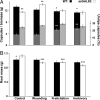SNF1-related kinases allow plants to tolerate herbivory by allocating carbon to roots
- PMID: 16912118
- PMCID: PMC1568949
- DOI: 10.1073/pnas.0602316103
SNF1-related kinases allow plants to tolerate herbivory by allocating carbon to roots
Abstract
Herbivore attack elicits costly defenses that are known to decrease plant fitness by using resources that are normally slated for growth and reproduction. Additionally, plants have evolved mechanisms for tolerating attack, which are not understood on a molecular level. Using 11C-photosynthate labeling as well as sugar and enzyme measurements, we found rapid changes in sink-source relations in the annual Nicotiana attenuata after simulated herbivore attacks, which increased the allocation of sugars to roots. This herbivore-induced response is regulated by the beta-subunit of an SnRK1 (SNF1-related kinase) protein kinase, GAL83, transcripts of which are rapidly down-regulated in source leaves after herbivore attack and, when silenced, increase assimilate transport to roots. This C diversion response is activated by herbivore-specific elicitors and is independent of jasmonate signaling, which regulates most of the plant's defense responses. Herbivore attack during early stages of development increases root reserves, which, in turn, delays senescence and prolongs flowering. That attacked GAL83-silenced plants use their enhanced root reserves to prolong reproduction demonstrates that SnRK1 alters resource allocation so that plants better tolerate herbivory. This tolerance mechanism complements the likely defensive value of diverting resources to a less vulnerable location within the plant.
Conflict of interest statement
Conflict of interest statement: No conflicts declared.
Figures






References
-
- Karban R., Baldwin I. T. Induced Responses to Herbivory. Chicago: Univ. of Chicago Press; 1997.
-
- Tiffin P. Evol. Ecol. 2000;14:523–536.
-
- Stowe K. A., Marquis R. J., Hochwender C. G., Simms E. L. Annu. Rev. Ecol. Syst. 2000;31:565–595.
-
- Strauss S. Y., Watson W., Allen M. T. Ecology. 2003;84:2074–2082.
-
- Mauricio R. Evol. Ecol. 2000;14:491–507.
Publication types
MeSH terms
Substances
Associated data
- Actions
LinkOut - more resources
Full Text Sources
Other Literature Sources

